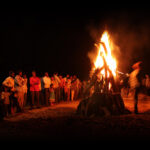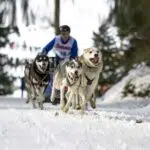Iditarod Trail Sled Dog Race takes place in the U.S. on March 3 every year. Simply referred to as Iditarod, it’s a popular annual long-distance sled dog race that travels from Anchorage to Nome, all within the American state of Alaska. The race has mushers and a team of between 12 and 14 dogs that must cover the distance in eight to 15 days or more. The Iditarod was established in 1973, starting as an event to test the best sled dog mushers and teams and becoming a highly competitive race over time.
History of Iditarod Trail Sled Dog Race
This is a long-distance sled dog race where teams usually race through blizzards causing whiteout conditions and sub-zero temperatures. Gale-force winds can cause the wind chill to reach −100 °F. There is a ceremonial start that takes place in the city of Anchorage. Then there is an official restart in Willow, a city located about 80 miles north of Anchorage. Up to 2007, the restart took place in Wasilla, but later, in 2008, it moved to Willow due to less snow.
The Iditarod trail runs from Willow up the Rainy Pass of the Alaska Range. It goes into the sparsely populated interior. The trail continues along the shore of the Bering Sea and reaches Nome in western Alaska. The Iditarod trail goes through a rugged landscape of tundra and spruce forests, over hills and mountain passes. It also goes across rivers and over sea ice. The start in Anchorage takes place in the middle of a large urban center. The route, however, passes through widely separated villages and towns.
The Iditarod is considered a symbolic link to the early history of Alaska. It is connected to many traditions that commemorate the legacy of dog mushing, and the race is an important and popular sporting event to people. The top mushers and their teams of dogs are considered local celebrities in the state.
Iditarod Trail Sled Dog Race timeline
Athabaskan and Inupiaq peoples use the trail before the arrival of Russian fur traders.
The trail reaches its peak when miners arrive to dig coal and later gold.
The Alaska gold rush to Nome takes place.
Dog sledding is almost driven into extinction by the increased use of snowmobiles.
Iditarod Trail Sled Dog Race FAQs
Which musher has four consecutive wins?
Lance Mackey is the only musher to have four consecutive wins. He won in 2007, 2008, 2009, and 2010.
Are there legacy Iditarod winners?
In 1983, Rick Mackey became the first legacy Iditarod winner. He is the son of an Iditarod champion.
Who is the youngest musher?
In 2005, Dallas Seavey became the youngest musher to run the Iditarod Trail Sled Dog Race at the age of 18.
Iditarod Trail Sled Dog Race Activities
Pet a dog
You can pet a dog around you. You can also visit a kennel to pet some dogs.
Watch a race
You can watch a dog sledding race. It is a fun sport to watch.
Share the holiday
You can share the fun holiday with the people you know. You can share it online or with friends in person.
5 Interesting Facts About Iditarod
Butcher breaks Swenson's record
By completing the Iditarod in 11 days, 15 hours, and six minutes, Susan Butcher broke Rick Swenson’s record.
More records are broken
Mitch Seavey broke all previous records by completing the race in eight days, three hours, 40 minutes, and 13 seconds.
Some racers are slower
The slowest winning time at the 1974 race was made by Carl Huntington, completing it at 20 days, 15 hours, two minutes, and seven seconds.
Many dogs participate
Over 1,000 dogs leave Anchorage for Nome.
There are checkpoints
There are 23 checkpoints on the northern route and about 24 on the southern route of the race.
Why We Love Iditarod Trail Sled Dog Race
Iditarod is fun
The holiday encourages fun sports activities. It is exciting for the watchers and the participants.
Iditarod is cultural
The holiday is part of the culture in Alaska. It attracts many people to watch it.
It is aspirational
Iditarod gives people something to aspire to. They can train and try to beat past records.
Iditarod Trail Sled Dog Race dates
| Year | Date | Day |
|---|---|---|
| 2026 | March 3 | Tuesday |
| 2027 | March 3 | Wednesday |
| 2028 | March 3 | Friday |
| 2029 | March 3 | Saturday |
| 2030 | March 3 | Sunday |








































